As the world navigates a turbulent spring in 2025, bitcoin and gold find themselves at a fascinating crossroads. With Bitcoin languishing at a five-month low of USD 74,434 and gold soaring past USD 3,000 per ounce, the contrast between these two assets has never been starker.
While gold basks in its timeless role as the ultimate safe haven—bolstered by China’s relentless accumulation and a global shift away from the US dollar – Bitcoin struggles to shrug off a -32% correction from its January peak of USD 109,356. Yet, amid oversold conditions, panicked sentiment, and a bullish seasonal window, the cryptocurrency could be poised for an unexpected rebound.
As the second quarter of 2025 begins, both Bitcoin and the broader crypto sector present a mixed picture. On one hand, innovations and an unrelenting forward-looking perspective continue to inject fresh momentum into the space. On the other hand, the constantly shifting narratives are increasingly feeling forced and exhausting.
Bitcoin remains heavily speculation-driven, closely correlated with U.S. tech stocks, and now firmly in Wall Street’s grip. Yet, the past three months have also underscored Bitcoin’s resilience, delivering notable progress in institutional adoption and positive regulatory developments.
However, the strong momentum from November and December of last year only carried Bitcoin to a marginal new all-time high of USD 109,356 on January 20th. Since then, it has gradually declined, dropping over -32% from its peak. At the start of this week, it hit a five-month low of USD 74,434.
While the S&P 500 has already staged a significant recovery from Monday’s panic low, Bitcoin is lagging behind. A convincing trend reversal is not yet in sight, even though sentiment has hit rock bottom.
Bitcoin CME Future Gap Closed
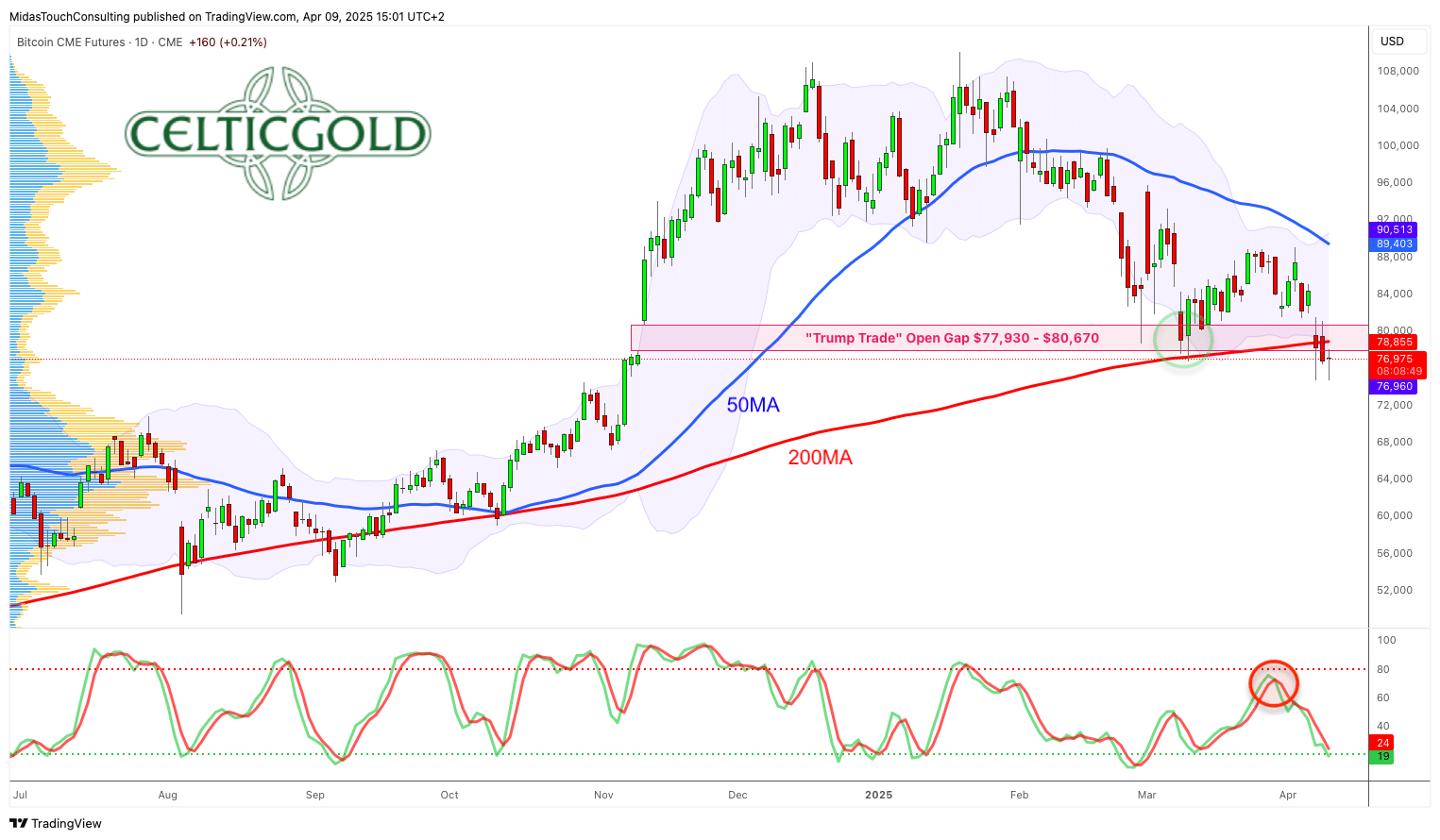
Still, Monday may have marked the bottom of this corrective move. Crucially, as we suspected back in early January, the open gap in Bitcoin futures has now been fully closed. Currently, Bitcoin futures are hovering around the 200-day moving average (USD 78,855) and searching for support. If the stock market stabilizes and subsequently mounts a broader recovery, the crypto sector could soon see brighter days.
Ethereum Underperforming Dramatically
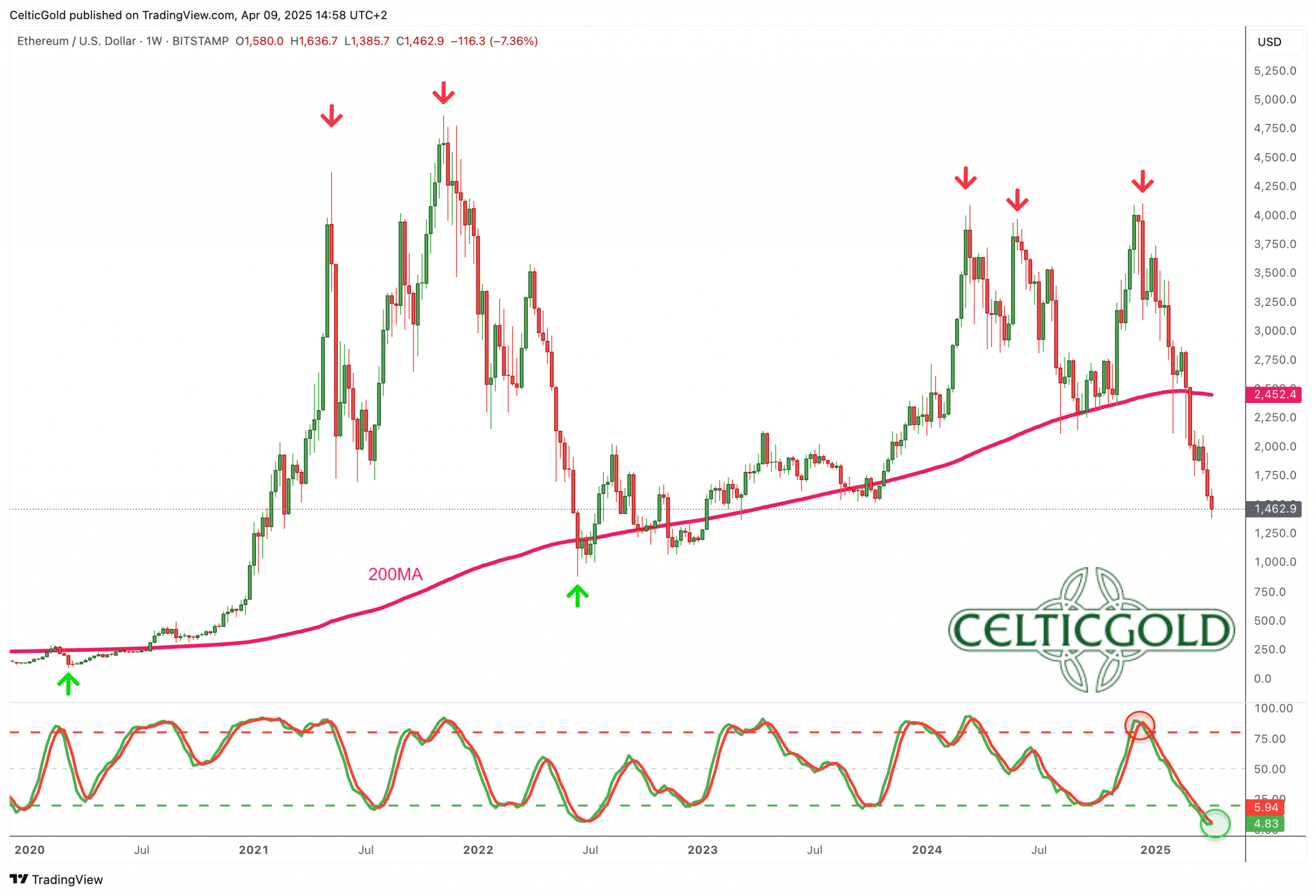
Ethereum’s dismal performance, however, remains a big question mark. While Bitcoin and newer Layer-1 blockchains like Solana or Avalanche have surged since autumn 2022, Ethereum has fallen well short of its 2021 all-time high of USD 4,864, peaking at just USD 4,094 this time around.
Instead, the correction over the past three-and-a-half months has pushed Ethereum down to a low of USD 1,411. Against Bitcoin, Ethereum is even trading at a five-year low!
Ethereum sits at a technological crossroads between decentralization, security, and scalability. While its often-criticized transaction speeds and high fees don’t fully explain the declining price and weak performance, progress has been made since the successful merge to Proof-of-Stake and the introduction of Layer-2 solutions like Arbitrum and Optimism.
These advancements have improved scalability without sacrificing core decentralization principles. Moreover, Ethereum remains the leading platform for smart contracts and decentralized applications.
In the fast-paced crypto world, however, market psychology, macroeconomic factors, and competition from newer projects play outsized roles. In our view, the criticism of Ethereum’s price performance is justified. The market seems to know more already, and we plan to fully divest from Ethereum during the next major recovery.
Technical Analysis for Bitcoin in US-Dollar
Weekly Chart: Support Around USD 74,000 Still Holding Strong
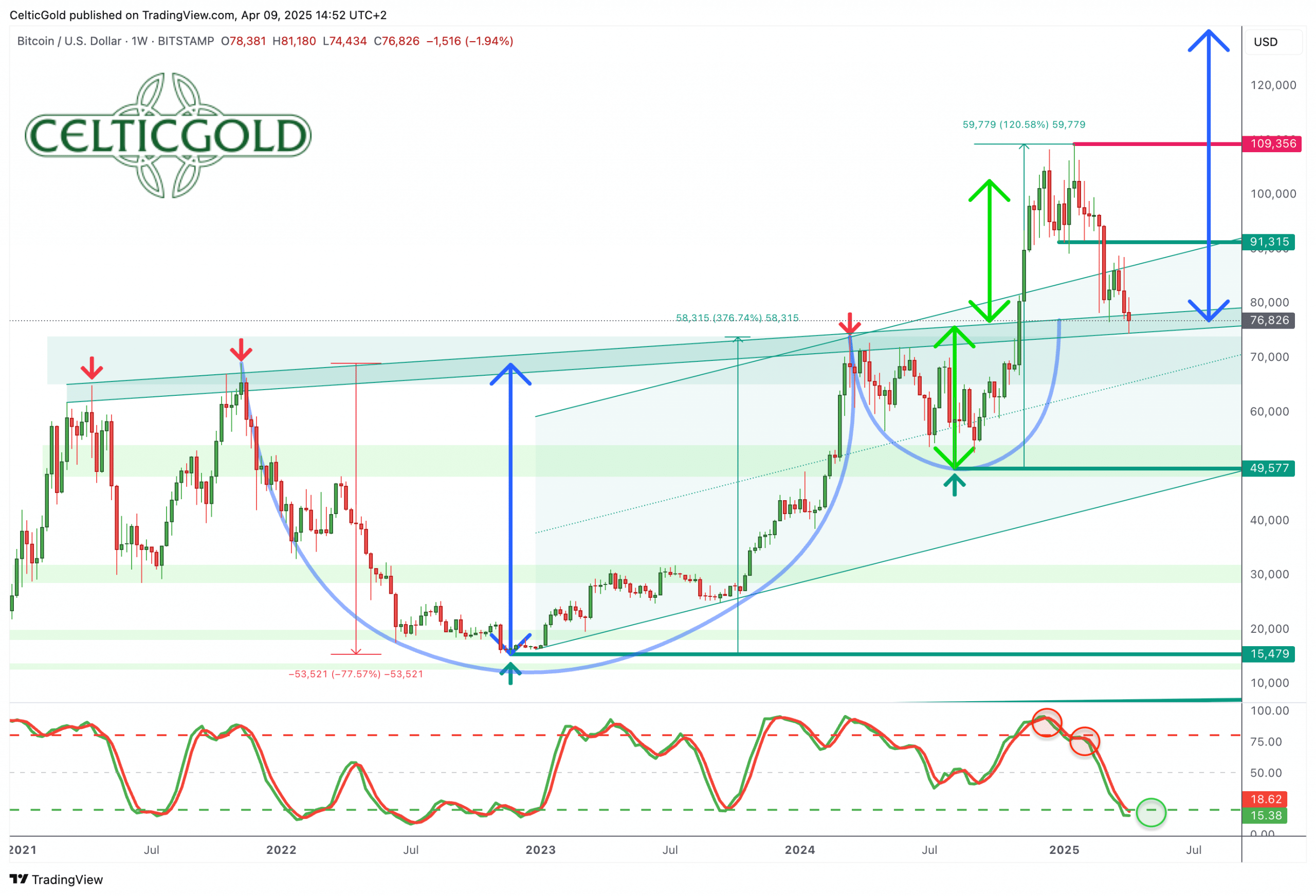
After Bitcoin worked off the first target of its cup-and-handle formation around USD 104,000, the bulls quickly ran out of steam. For nearly two months, it oscillated around the psychologically significant USD 100,000 mark but ultimately stalled there. Collapsing U.S. stock markets then triggered mounting selling pressure starting in late January, leading to a downward trend reversal.
Back then, the weekly stochastic indicator had clearly turned and has since entered oversold territory, suggesting that contrarian investors should now be on the lookout for buying opportunities. That said, price action so far remains unconvincing.
At the same time, the old resistance zone (now support) around the March 2024 high of USD 73,793 has held firm without issue. In fact, the correction’s low of USD 74,434 didn’t even test this zone. As such, this can still be viewed as a healthy pullback to the former resistance. However, the bulls need to step back into the market soon.
Overall, the weekly chart remains bearish. That said, it wouldn’t take much for the stochastic oscillator to flash a new buy signal. Should that happen, there’d be plenty of room and time for an upward move.
Daily Chart: Still in the Bears’ Grip
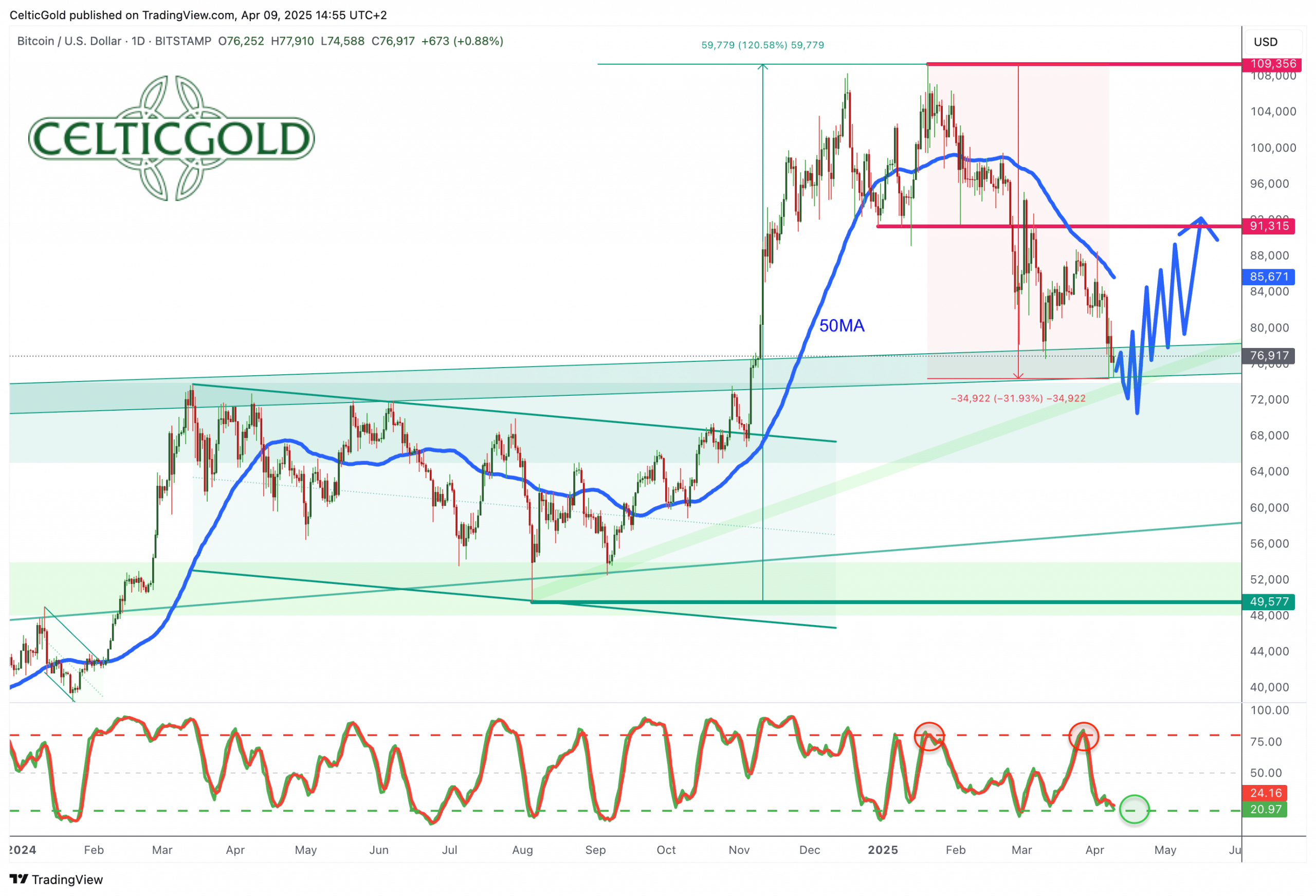
On the daily chart, Bitcoin is now trading well below its 50-day moving average (USD 85,671) and its still-rising 200-day moving average (USD 86,953). Combined with lower highs and lower lows, a downtrend has been in place since January 20. Breaking this downtrend would require a move above the spike high of USD 88,563 from April 2nd.
That said, the stochastic indicator on the daily chart is also somewhat oversold and attempting to turn upward. If it succeeds, the bulls could ride a wave of momentum higher in April. Indeed, the combination of an oversold stochastic on both the daily and weekly charts is highly promising from a contrarian perspective. After all, the adage holds: buy low, sell high.
Overall, the daily chart remains bearish. However, we’re seeing growing signs of an impending trend reversal, with the potential for a significant recovery in the coming months. A rise to at least the USD 88,000 – USD 90,000 range should be achievable, provided support above USD 70,000 holds.
Bitcoin Sentiment – Panic Everywhere You Look
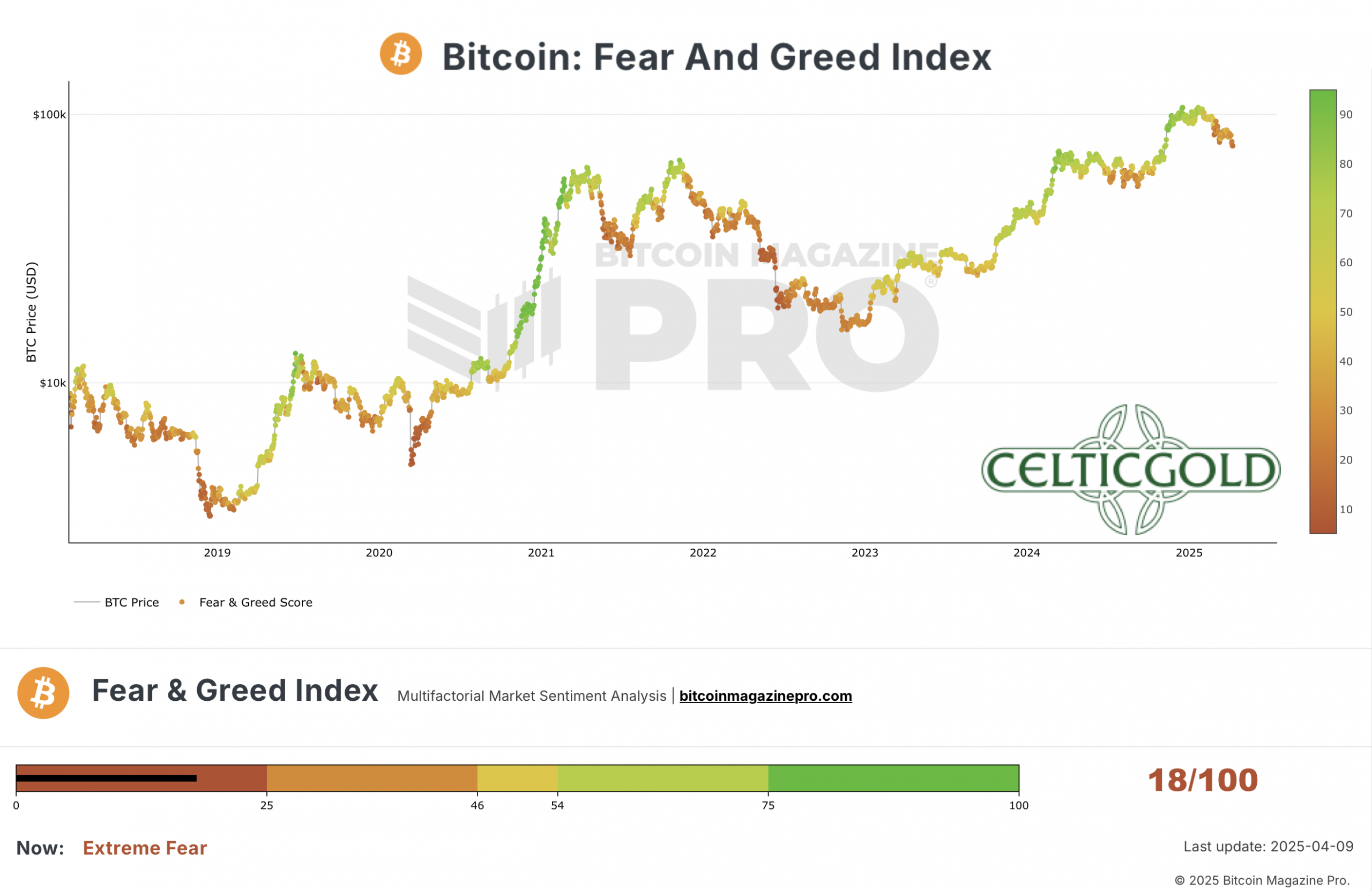
The Crypto Fear & Greed Index currently stands at 18 out of 100, signaling that sentiment is at rock bottom and pure panic has gripped crypto enthusiasts. While such conditions can persist, they generally set the stage for an ideal contrarian opportunity.
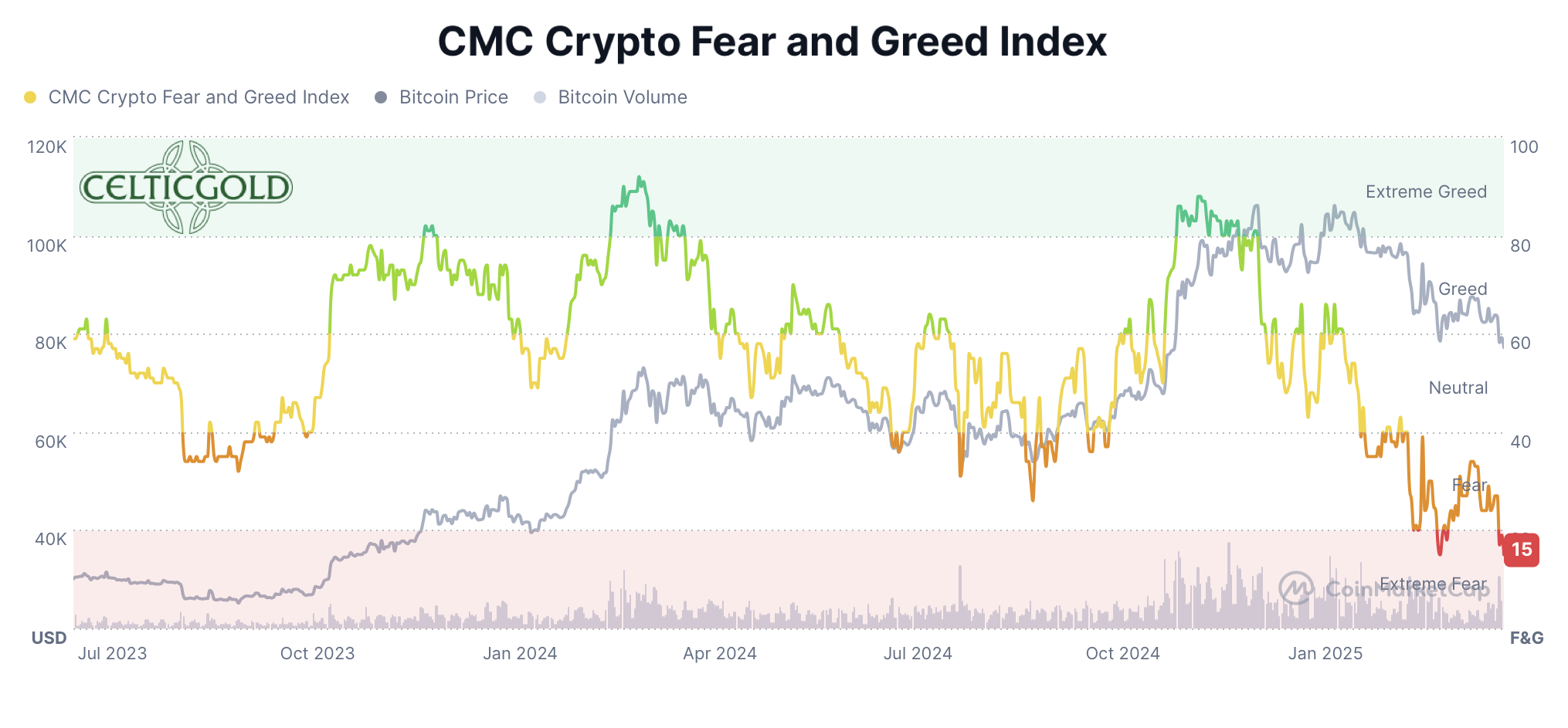
CoinMarketCap’s CMC Crypto Fear & Greed Index also reports elevated fear levels, reinforcing the contrarian potential.
In sum, sentiment is delivering a clear and unambiguous contrarian buy signal.
Bitcoin Seasonality – Extremely Positive Through June
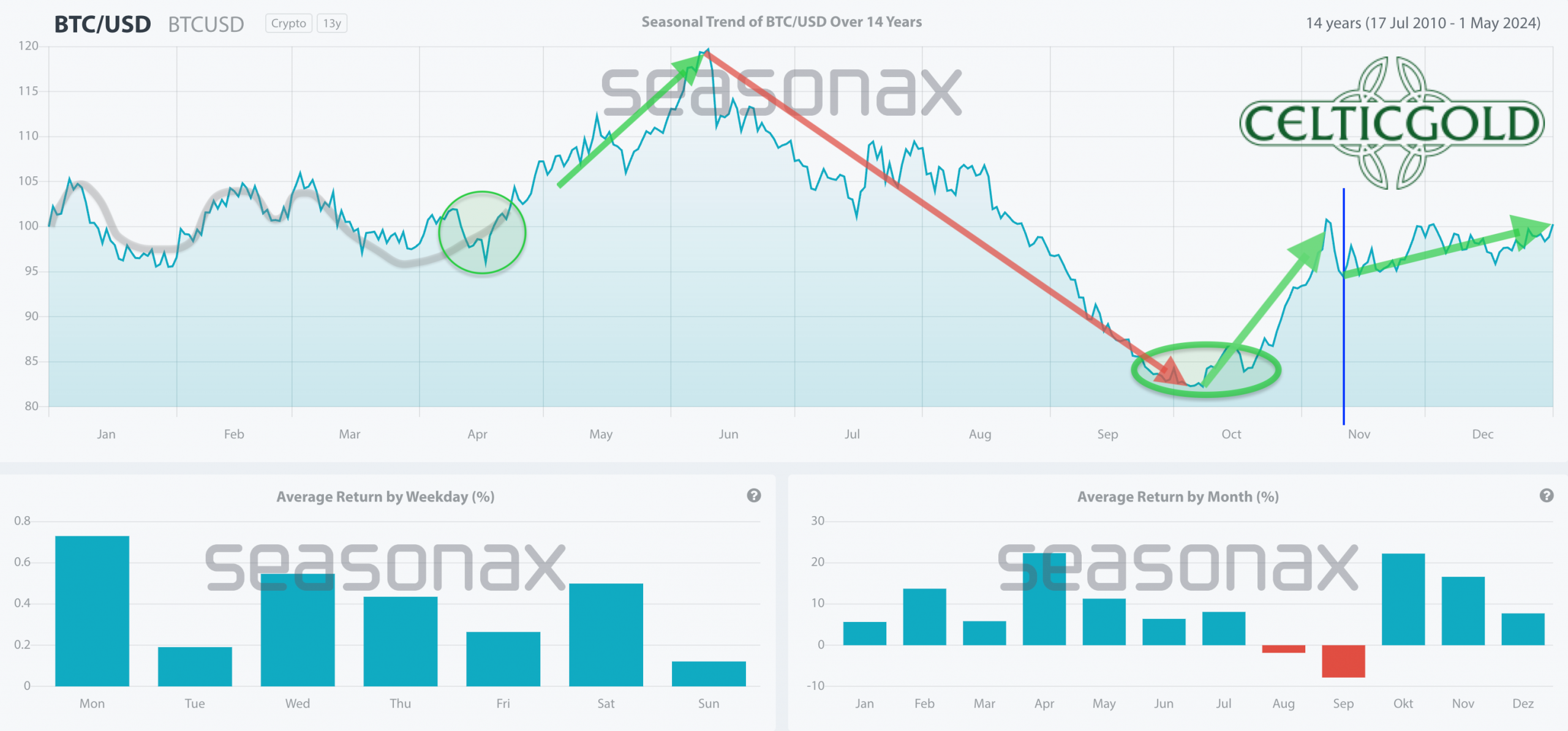
While seasonal patterns since the start of the year suggested a sideways consolidation, a sharp sell-off hit instead from late January onward.
Starting in mid-April, however, seasonality turns decidedly bullish. Historically, over the past 15 years, Bitcoin has typically posted significant gains from spring through mid-June. Combined with the deeply oversold conditions on both weekly and daily charts, plus panicked sentiment, the setup is exceptionally promising.
In short, the seasonal traffic light is turning green, underscoring the contrarian opportunity for Bitcoin.
Sound Money – Bitcoin vs. Gold (Bitcoin/Gold Ratio)
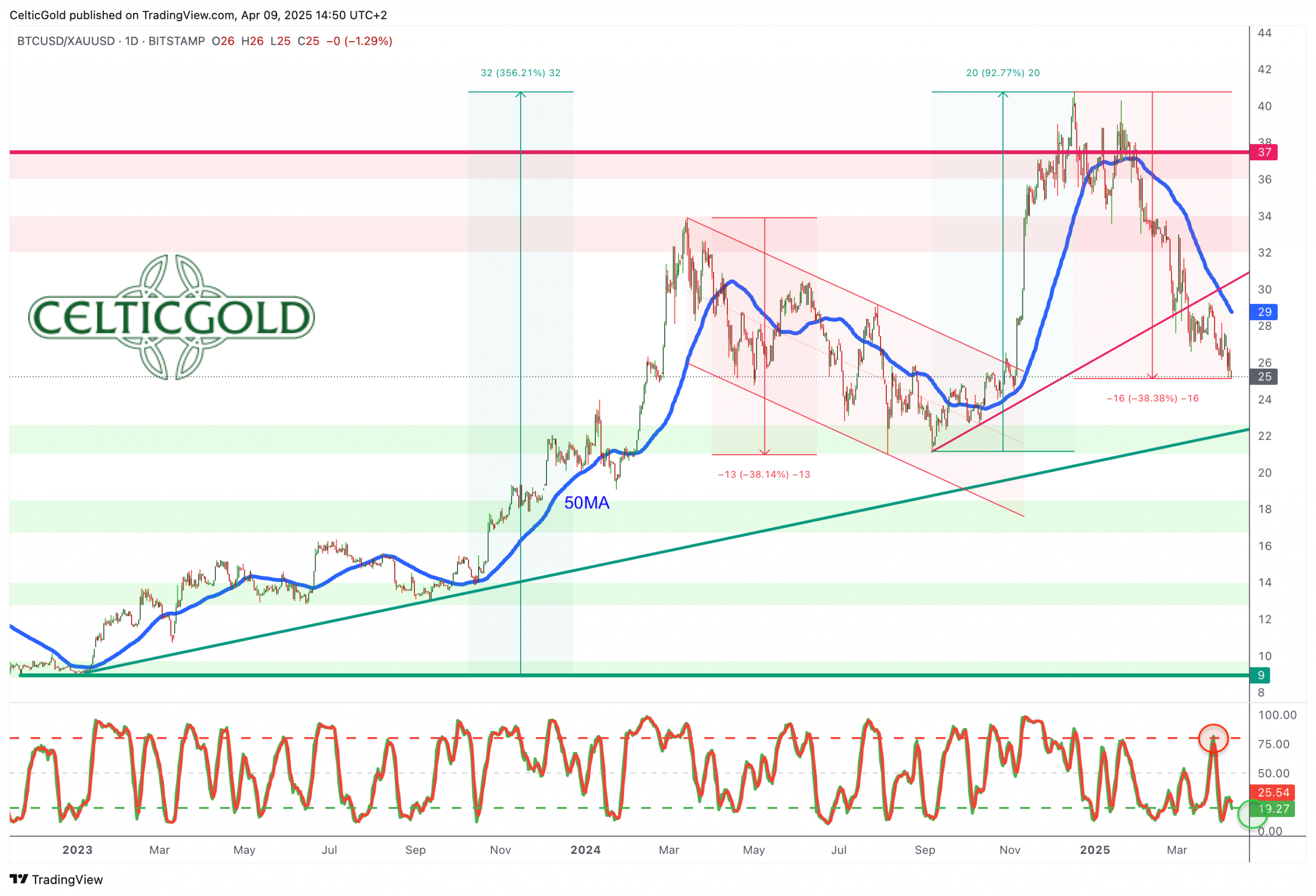
With Bitcoin at around USD 77,000 and gold at approximately USD 3,055 per ounce, one Bitcoin currently buys 25.24 ounces of gold. Put another way, one ounce of gold costs about 0.039 Bitcoin. That marks a -38% decline in Bitcoin’s value against gold since mid-December!
Much like Bitcoin’s daily and weekly charts, as well as the broader market sentiment, the Bitcoin/Gold ratio also reflects a deeply oversold state, further highlighting Bitcoin’s contrarian potential. However, a trend reversal isn’t yet visible. The next support for the ratio lies at around 22 – 23, while the fast-dropping 50-day moving average (29) is likely to cap or halt any initial recovery attempts.
In sum, the Bitcoin/Gold ratio confirms gold’s strong outperformance amid these uncertain times. Despite Bitcoin’s over -38% drop against gold in the past three-and-a-half months, a reversal isn’t yet in sight. The situation remains intriguing, as gold appears ripe for a correction, but geopolitical tensions continue to drive fresh demand for the ultimate money and safe haven: gold.
Macro Update – China’s Gold Strategy Forces Trump’s Tariff Revolution
The macroeconomic and geopolitical landscape has grown so multifaceted and complex that we feel compelled to dive deeper this time.
On November 15th, 2012, Xi Jinping assumed the role of General Secretary of the Chinese Communist Party (CCP), followed by his appointment as President of the People’s Republic of China in March 2013. This marked the start of his rise as the country’s “paramount leader,” consolidating control over the party, state, and military in the years that followed. From the outset, Xi prioritized national sovereignty and economic independence.
China’s Gradual Reduction of US Treasuries
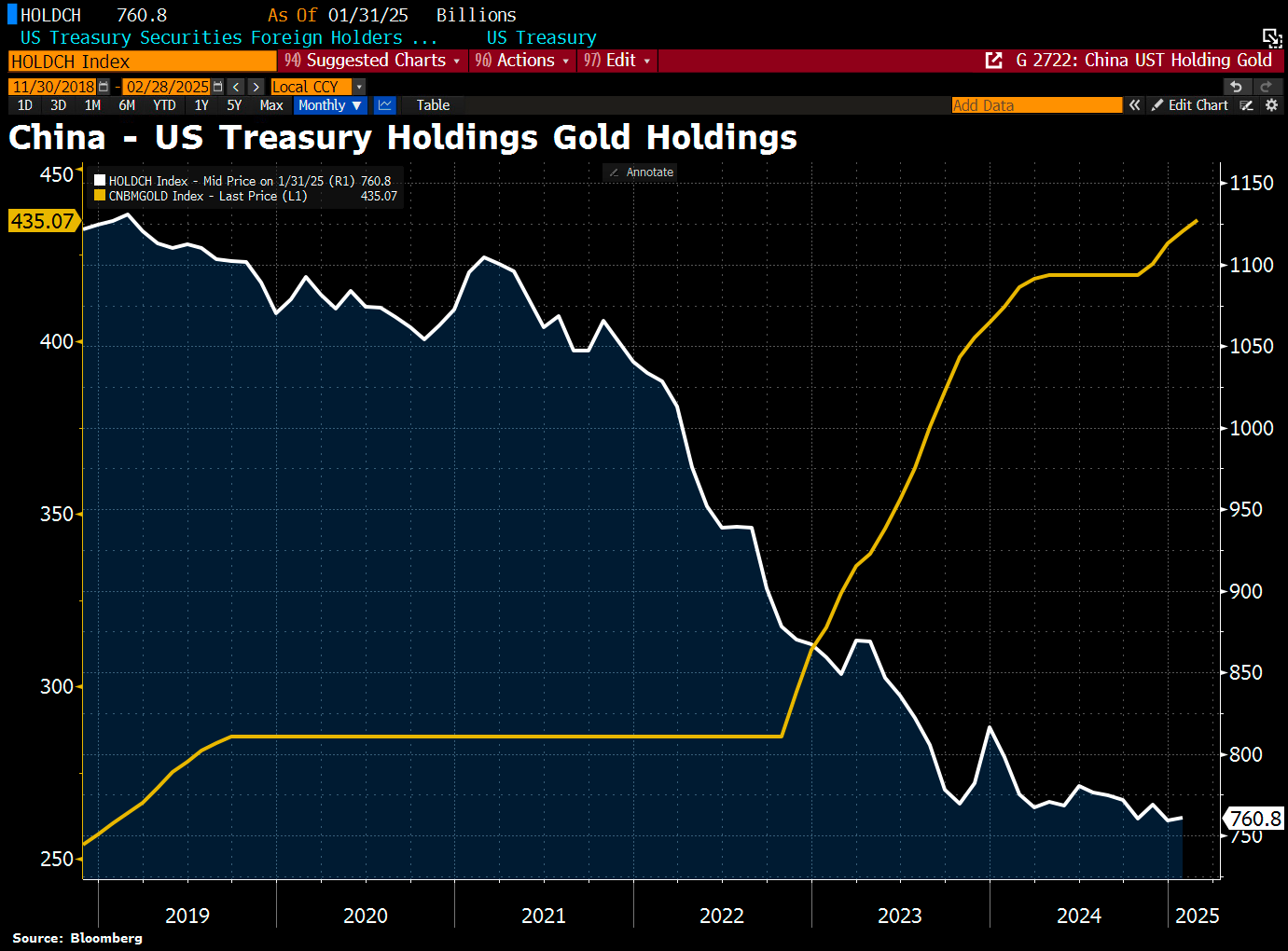
Just months later, in 2013, China began steadily reducing its holdings of U.S. Treasury bonds. These peaked at around USD 1.3 trillion by late 2013. The pace of reduction accelerated in subsequent years, dipping below USD 1 trillion in 2022. By January 2025, China’s U.S. Treasury holdings hit USD 761 billion – the lowest level since 2009. Meanwhile, China has aggressively stockpiled gold.
Unsurprisingly, geopolitical tensions and economic uncertainties have risen globally since 2013. That year, China started unwinding its symbiotic yet imbalanced economic relationship with the U.S. (often dubbed “Chimerica”) to reduce reliance on the U.S. dollar, challenging America’s global dominance in the process.
For decades—especially in the 2000s—the U.S. exported its intrinsically worthless dollar worldwide, living well beyond its means. America provided security guarantees, weapons, and military support, while emerging markets like China produced cheap goods for U.S. consumers, and oil-rich nations like Saudi Arabia supplied oil at stable prices. These countries then reinvested their dollar earnings into U.S. Treasuries.
Consequently, the U.S. trade balance has been consistently negative since 1976. In the 1950s and 1960s, the U.S. typically ran trade surpluses, buoyed by its robust industrial base and post-WWII reconstruction efforts. The shift began in the 1970s, with imports permanently outpacing exports. A pivotal moment came in 1971 when President Nixon abandoned the Bretton Woods system, unpegging the dollar from gold and ushering in flexible exchange rates. This set the stage for a gradual deterioration of the U.S. trade balance.
Historical Evolution of the U.S. Trade Deficit
Since 1976, the deficit has steadily widened, with brief dips—like after the 2008/2009 financial crisis—proving temporary. The causes are manifold: rising consumption (often on credit), a strong dollar favoring imports, and the offshoring of industry and production to cheaper countries like China since the 1980s. Today, the U.S. deficit hovers between USD 1 trillion and USD 1.5 trillion annually.
As social and economic crises escalate in the U.S., this persistent trade deficit has unsurprisingly become a central issue in U.S. economic policy. Millions grapple with poverty, homelessness, and addiction (e.g., fentanyl from China), while demand for U.S. debt wanes. This has driven interest rates sharply higher, significantly raising living costs worldwide.
Trump’s Radical Counterstrategy
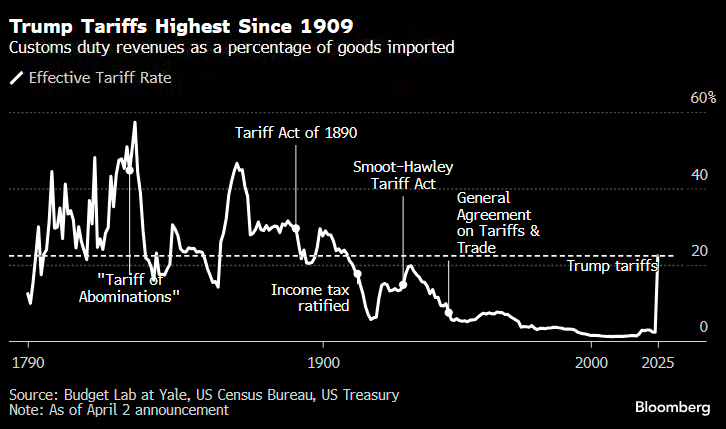
While Democratic administrations under Obama and Biden continued the imperialist U.S. policies of the 1970s onward, Republican Donald Trump is countering with an America-first strategy akin to an aggressive businessman. His measures are radical and could spell the end of the current world order—yet they may represent America’s last chance to curb China’s growing dominance.
Trump’s “Liberation Day” marks the end of decades-long U.S. interventions abroad, once aimed at defeating communism and establishing the dollar as the world’s reserve currency. Introducing tariffs, however, carries significant risks. While they could spark a medium-term U.S. industrial renaissance, they also threaten trade wars and economic downturns. Higher import costs are likely to fuel inflation, hitting U.S. consumers hard initially.
Geopolitically, retaliatory measures from trading partners could deepen U.S. isolation and hasten a multipolar world order. China has already announced retaliatory tariffs on U.S. goods, set to rise from 34% to 84% starting April 10! Rising debt, disrupted trade flows, and weakened alliances further jeopardize U.S. financial stability and the dollar’s value. Trump’s tariff policy will likely accelerate new trade agreements, eroding U.S. global economic power and the dollar’s international role.
Financial Markets Under Intense Pressure
The stock market crash can thus be seen as a “cold withdrawal”: painful and economically risky, but politically opportune and necessary. No one has dared attempt this before, and it’s fraught with uncertainty. It could even trigger a global economic crisis reminiscent of the 1930s Depression.
As such, the oversold conditions in stocks and Bitcoin should be approached cautiously. Without central bank intervention, the bottom could still be far off.
Meanwhile, gold prices remain robust, as China continues buying physical gold, systematically pressuring the Anglo-Saxon paper-gold fraud system of recent decades. With prices above USD 3,000, gold is overvalued relative to silver and oil, but the reason is clear. Gold is reclaiming its status as the only true money, gaining prominence as the ultimate store of value amid economic uncertainty and distrust in fiat currencies.
Bitcoin Is No Rival to Gold
Bitcoin, as a modern player, shares some traits with gold but fits only partially into its narrative, as it has yet to prove itself as an ultimate store of value in crises.
Both aim to serve as alternatives to inflationary fiat currencies and are touted by advocates as hedges against currency devaluation. Bitcoin’s nickname “digital gold” highlights this parallel, given its scarcity and resistance to manipulation – attributes increasingly valued amid waning trust in central banks.
Yet gold and Bitcoin differ fundamentally in nature and perception. Gold is physical, universally accepted, requires no electricity or internet, and boasts a millennia-long history as a medium of exchange and store of value. Bitcoin, a digital innovation since 2009, feels abstract by comparison. While gold exhibits stable value growth, Bitcoin’s high volatility casts doubt on its role as “real money” for skeptics. Moreover, gold is rarely used for daily transactions today and is instead hoarded, whereas Bitcoin – originally envisioned as a payment system—has morphed into a speculative asset.
Bitcoin thus complements rather than competes with gold – a modern twist on the same principle in a digitized world. As long as stock markets remain under pressure and central banks stay sidelined, Bitcoin’s road ahead looks bumpy.
Bitcoin – While Gold Shines, Bitcoin Could Surprise
As of early April 2025, Bitcoin faces a complex mix of macroeconomic uncertainties, geopolitical tensions, collapsing stock markets, and battered market psychology. Signs of an impending trend reversal are emerging—supported by oversold technicals and favorable seasonality through mid-June – but its reliance on U.S. equity markets and Ethereum’s glaring weakness cloud the outlook.
The recent correction to a five-month low of USD 74,434 reflects this uncertainty, while gold solidifies its role as a stable store of value amid rising geopolitical risks. Bitcoin remains a speculative player that has yet to cement its status as “digital gold.” Gold, bolstered by China’s massive purchases and a global economy distancing itself from U.S. dollar dominance, outshines all as “the only true money” these days. Bitcoin, meanwhile, grapples with volatility and limited acceptance as a payment medium. That said, the current setup offers significant contrarian opportunities for Bitcoin if stocks rebound.
The crypto sector as a whole faces a trial by fire, while gold plays to its historical strengths. The coming months could prove pivotal for Bitcoin. If the broad support zone between USD 70,000 and USD 75,000 holds, a spring recovery could push prices above USD 88,000 and restore shaken confidence. In January, we forecast a wide trading range of USD 70,000 to USD 150,000 for the year, along with “extreme volatility.” That view holds. For now, though, the upside potential is starting to outweigh the downside.
